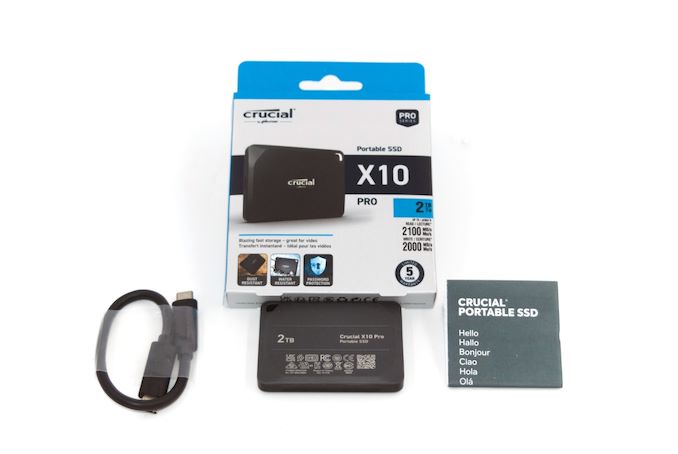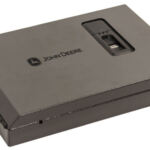- Like
- SHARE
- Digg
- Del
- Tumblr
- VKontakte
- Flattr
- Buffer
- Love This
- Save
- Odnoklassniki
- Meneame
- Blogger
- Amazon
- Yahoo Mail
- Gmail
- AOL
- Newsvine
- HackerNews
- Evernote
- MySpace
- Mail.ru
- Viadeo
- Line
- Comments
- Yummly
- SMS
- Viber
- Telegram
- JOIN
- Skype
- Facebook Messenger
- Kakao
- LiveJournal
- Yammer
- Edgar
- Fintel
- Mix
- Instapaper
- Copy Link
The increasing popularity of portable SSDs has prompted almost all tier-one NAND flash manufacturers to jump into the market. Over the last decade, both Samsung and SanDisk / Western Digital have been presenting consumers with a range of PSSD offerings targeting different sub-segments. On the other hand, the flash-based storage lineup from Crucial (Micron’s consumer-facing brand) has had a distinctive focus on internal SSDs. The company introduced its first PSSD only in 2019 (the X6), and followed it up with the X8 a year later. Both these drives used QLC NAND, making it suitable only for mainstream consumers on a budget.
The company shifted focus to power users in the PSSD segment earlier this year with the launch of two new products – the USB 3.2 Gen 2 X9 Pro, and the USB 3.2 Gen 2×2 X10 Pro. These 1 GBps and 2 GBps-class drives come with a Type-C port and a Type-C to Type-C cable (Type-A adapter sold separately). The performance specifications of these two products indicate suitability for power users – for the first time, the company is quoting write speeds for their PSSDs in the marketing material.
We had taken a comprehensive look at the 2TB version of the X9 Pro in August. Following that review, Crucial sampled us all three capacity points of the X10 Pro to put through the same evaluation routine. This review takes a detailed look at the performance and value proposition of the different X10 Pro SKUs, with a particular focus on how they stack up against the existing players at each capacity point.
Introduction and Product Impressions
Portable SSDs have gained rapid market presence, thanks to advancements in flash technology and the appearance of fast host interfaces for external devices. This has enabled the product category to appeal to a wide range of users with different budgets and performance requirements. Continued technological progress on both fronts has resulted in bus-powered direct-attached storage devices growing in both storage capacity and speeds. The Type-C standard has also achieved widespread acceptance in the consumer market. Protocols such as USB 3.2 Gen 2×2 / USB4 and Thunderbolt riding on top of the Type-C connector have enabled the introduction of palm-sized flash-based storage devices capable of delivering 20 Gbps (2 GBps+) speeds.
The thermal aspect is an important consideration for high-speed storage devices. Bridge-based solutions with multiple protocol conversion chips generally dissipate more power due to the additional components. High-performance portable SSDs in the past have had no option but to use them – first, with SATA bridges, and then with NVMe bridges. The introduction of native UFD controllers capable of hitting 10 Gbps and 20 Gbps from Phison and Silicon Motion has opened up yet another option in this category. The Crucial X6, equipped with the Phison U17, was reviewed in August 2021 and was one of the first retail products to surpass the SATA speeds barrier by hitting 800 MBps speeds without using a NVMe bridge. Around the same time, Silicon Motion’s SM2320 powered the Kingston XS2000 to 20 Gbps speeds without using a bridge chip.
Products based on Silicon Motion’s SM2320 have gained a lot of consumer mindshare because they have typically been able to hit the interface speed limits for sequential accesses in both the 10 Gbps and 20 Gbps categories. However, consistency was an issue as the initial wave of products used Micron’s 96L 3D TLC or BiCS 4 / BiCS 5 (up to 112L) 3D TLC NAND. The introduction of faster flash has since allowed portable SSDs (PSSDs) based on the native UFD controllers to hit higher speeds and maintain them even in direct-to-TLC scenarios.
The X10 Pro units we are looking at in this review are 42g 65mm x 50mm USB 3.2 Gen 2×2 PSSDs made of anodized aluminum. They includes a lanyard hole (with the LED near the hole, rather than near the Type-C port) and a rubberized soft-touch base for protection against bumps. The sides are slightly recessed for better traction during handling. Similar to the X9 Pro, the X10 Pro is also IP55 rated, and drop-proof up to 7.5′. The packaging is minimal – a short USB 3.2 Gen 2 Type-C to Type-C cable and a user guide in addition to the main unit.
Similar to the X9 Pro, the X10 Pro also uses the Silicon Motion SM2320 native controller (albeit, in a 20 Gbps USB 3.2 Gen 2×2 configuration) along with Micron’s 176L 3D TLC NAND packages.
CrystalDiskInfo provides a quick overview of the capabilities of the internal storage device. TRIM and NCQ are not seen in the features list, though we have seen those available in other PSSDs based on the Silicon Motion SM2320. However, we did confirm that TRIM was actually supported using the Windows Optimize-Volume ReTrim option for all the X10 Pro SKUs. The benchmark numbers in the next section also show that native command queuing is active in the PSSD, and all S.M.A.R.T features such as temperature read outs worked well.
| S.M.A.R.T Passthrough – CrystalDiskInfo | |
 |
 |
The table below presents a comparative view of the specifications of the different storage bridges presented in this review.
| Comparative Direct-Attached Storage Devices Configuration | ||
| Aspect | ||
| Downstream Port | Native Flash | Native Flash |
| Upstream Port | USB 3.2 Gen 2×2 Type-C (Female) | USB 3.2 Gen 2×2 Type-C (Female) |
| Bridge Chip | Silicon Motion SM2320 | Silicon Motion SM2320 |
| Power | Bus Powered | Bus Powered |
| Use Case | 2GBps-class, sturdy palm-sized high-performance portable SSD with a Type-C interface | 2GBps-class, sturdy palm-sized high-performance portable SSD with a Type-C interface |
| Physical Dimensions | 65 mm x 50 mm x 10 mm | 65 mm x 50 mm x 10 mm |
| Weight | 42 grams | 42 grams |
| Cable | 22 cm USB 3.2 Gen 2×2 Type-C (male) to Type-C (male) | 22 cm USB 3.2 Gen 2×2 Type-C (male) to Type-C (male) |
| S.M.A.R.T Passthrough | Yes | Yes |
| UASP Support | Yes | Yes |
| TRIM Passthrough | Yes | Yes |
| Hardware Encryption | Yes | Yes |
| Evaluated Storage | Micron B47R 176L 3D TLC | Micron B47R 176L 3D TLC |
| Price | $290 | $169 |
| Review Link | Crucial X10 Pro 4TB Review | Crucial X10 Pro 2TB Review |
Prior to looking at the benchmark numbers, power consumption, and thermal solution effectiveness, a description of the testbed setup and evaluation methodology is provided.
Testbed Setup and Evaluation Methodology
Direct-attached storage devices (including thumb drives) are evaluated using the Quartz Canyon NUC (essentially, the Xeon / ECC version of the Ghost Canyon NUC) configured with 2x 16GB DDR4-2667 ECC SODIMMs and a PCIe 3.0 x4 NVMe SSD – the IM2P33E8 1TB from ADATA.
The most attractive aspect of the Quartz Canyon NUC is the presence of two PCIe slots (electrically, x16 and x4) for add-in cards. In the absence of a discrete GPU – for which there is no need in a DAS testbed – both slots are available. In fact, we also added a spare SanDisk Extreme PRO M.2 NVMe SSD to the CPU direct-attached M.2 22110 slot in the baseboard in order to avoid DMI bottlenecks when evaluating Thunderbolt 3 devices. This still allows for two add-in cards operating at x8 (x16 electrical) and x4 (x4 electrical). Since the Quartz Canyon NUC doesn’t have a native USB 3.2 Gen 2×2 port, Silverstone’s SST-ECU06 add-in card was installed in the x4 slot. All non-Thunderbolt devices are tested using the Type-C port enabled by the SST-ECU06.
The specifications of the testbed are summarized in the table below:
| The 2021 AnandTech DAS Testbed Configuration | |
| System | Intel Quartz Canyon NUC9vXQNX |
| CPU | Intel Xeon E-2286M |
| Memory | ADATA Industrial AD4B3200716G22 32 GB (2x 16GB) DDR4-3200 ECC @ 22-22-22-52 |
| OS Drive | ADATA Industrial IM2P33E8 NVMe 1TB |
| Secondary Drive | SanDisk Extreme PRO M.2 NVMe 3D SSD 1TB |
| Add-on Card | SilverStone Tek SST-ECU06 USB 3.2 Gen 2×2 Type-C Host |
| OS | Windows 10 Enterprise x64 (21H1) |
| Thanks to ADATA, Intel, and SilverStone Tek for the build components | |
The testbed hardware is only one segment of the evaluation. Over the last few years, the typical direct-attached storage workloads for memory cards have also evolved. High bit-rate 4K videos at 60fps have become quite common, and 8K videos are starting to make an appearance. Game install sizes have also grown steadily even in portable game consoles, thanks to high resolution textures and artwork. Keeping these in mind, our evaluation scheme for portable SSDs and UFDs involves multiple workloads which are described in detail in the corresponding sections.
- Synthetic workloads using CrystalDiskMark and ATTO
- Real-world access traces using PCMark 10’s storage benchmark
- Custom robocopy workloads reflective of typical DAS usage
- Sequential write stress test
In the next couple of sections, we have an overview of the performance of the three X10 Pro PSSDs in these benchmarks. Prior to providing concluding remarks, we have some observations on the drives’ power consumption numbers and thermal solution also.




